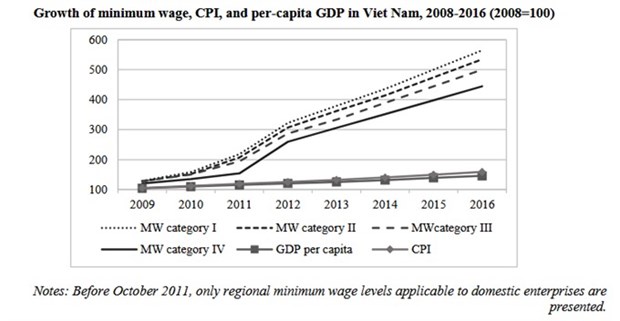Minimum wage rises, productivity stagnates
While labour productivity in Vietnam remains low, the drastically disproportionate increase of minimum wage and wages might harm business competitiveness and the development of the country.
 Growth of minimum wage, CPI, and per capita GDP in Vietnam in 2008-16 period.
Growth of minimum wage, CPI, and per capita GDP in Vietnam in 2008-16 period.Hanoi (VNS/VNA) - While labour productivity in Vietnam remains low compared with neighbouring countries, the drastically disproportionate increase of minimum wage and wages might harm the competitiveness of businesses and the development of the country.
The minimum wage grew at double-digit annual rates from 2007-2015, outpacing that of per-capita GDP and the consumer price index.
These findings were revealed in a report by the Vietnam Institute for Economic and Policy Research (VEPR) and Japanese economic experts which was released on September 13 in Hanoi at the workshop “Labour productivity and wage growth in Vietnam.”
Futoshi Yamauchi, senior economist from the World Bank, and member of the research team, said Vietnam’s minimum wage increases can have more negative effects than positive, citing the finding which showed an increase of 100 percent would cause profits over revenue of businesses to fall 3.25 percent.
Nguyen Duc Thanh, head of VEPR, expressed concerns over such differences.
“Continuously increasing minimum wage independent of the country’s labour productivity is contrary to other countries in the region. We, researchers, have to ask whether increasing minimum wage is just a way to ‘please’ employees and the majority of the people, regardless of the consequences it might bring to the overall economy?,” Thanh said.
He explained that the increase of minimum wage coupled with stagnant growth of productivity “erodes” businesses’ ability to accumulate capital and reduces investors’ desire to do business in the country, as well as their profits – a combination that undercuts the economy’s competitiveness.
Thanh’s calling ensuring minimum wage a “failed policy” was echoed by the majority of the experts at the workshop, who suggested the Government utilise other complimentary forms of social protection rather than relying on minimum wage. He also recommended switching to hourly minimum wage from the current monthly policy so as to better ensure the rights of more workers as well as afford more flexibility in recruitment and work arrangements for employers.
Truong Dinh Tuyen, former trade minister, explained that as a social protection tool, minimum wage policy can be considered “ineffective” as it fails to reach 50 percent of the labour force as it only covers contracted or salaried workers, while uncontracted workers are left out.
Some urged caution in branding the minimum wage policy a ‘failure’ as it’s a politically and socially sensitive issue, however, experts agreed that the focus on minimum wage at the central level should be shifted to finding ways to boost Vietnamese productivity, which can eventually be the determining factor for an employee’s wage.
Professor Kenichi Ohno, from Japan’s National Graduate Institute for Policy Studies, said he hasn’t seen “any serious action” from the Vietnamese government regarding the improvement of labour productivity. He added that in the future, Japan and Vietnam will have more concrete cooperation efforts in tackling this situation, in terms of changing the mindset as well as more research and resources on the development of successful foreign productivity-boosting models.
The minimum wage in Vietnam varies across the four regions, based on cost of living and location.
Region 1 covers urban Hanoi and HCM City, Region 2 covers rural Hanoi and HCM City along with urban areas of Can Tho, Da Nang and Hai Phong cities, Region 3 applies to provincial cities and the districts of Bac Ninh. Bac Giang, Hai Duong and Vinh Phuc provinces, and Region 4 takes care of the remaining localities.-VNA













